January 2023
January 26, 2023
An Electrifying Performance

The Carlisle Sentinel - Sep 28, 1983

Los Angeles Times - Sep 28, 1983
Posted By: Alex - Thu Jan 26, 2023 -
Comments (4)
Category: Accidents, 1980s
Artwork Khrushchev Probably Would Not Have Liked 48
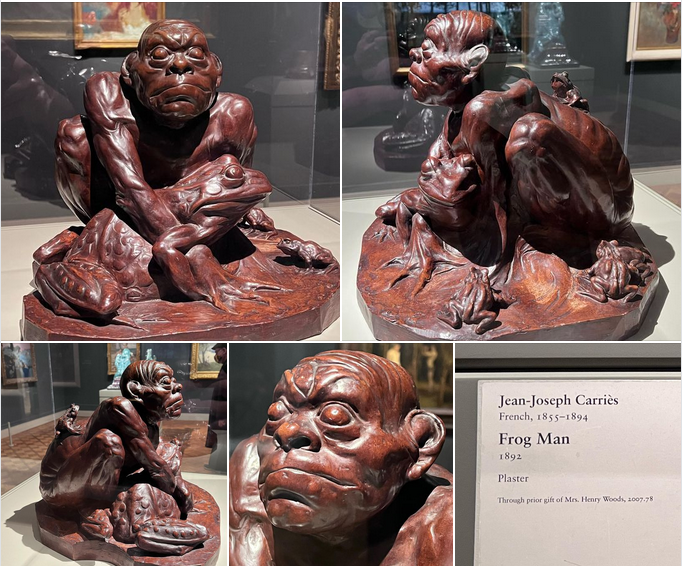
His Wikipedia page.
Posted By: Paul - Thu Jan 26, 2023 -
Comments (0)
Category: Animals, Art, Cryptozoology, Nineteenth Century
January 25, 2023
The Senster
Explanatory text from Are Computers Alive? Evolution and New Life Forms, by Geoff Simons (1983).Watch it in action below. The people desperately trying to get its attention clearly hadn't watched enough horror movies to know what usually happens next in situations with sentient machines.
More info: senster.com
Posted By: Alex - Wed Jan 25, 2023 -
Comments (2)
Category: Art, Technology, AI, Robots and Other Automatons, 1970s
Boogaloo in Apartment 41
You've never lived till you've heard a Mambo version of "Day Tripper."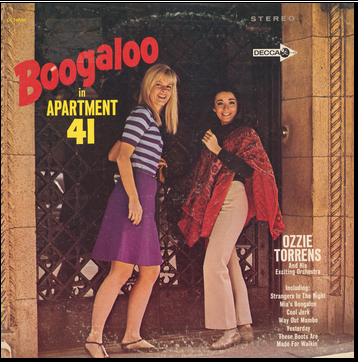
Tracklist:
1. Strangers In The Night
2. Mia’s Boogaloo
3. Day Tripper
4. Cool Jerk
5. Way Out Mambo
6. Boogaloo In Apt. 41
7. Yesterday
8. Tijuana Grass
9. Ozzaboo
10. These Boots Are Made For Walkin'
Posted By: Paul - Wed Jan 25, 2023 -
Comments (2)
Category: Music, Vinyl Albums and Other Media Recordings, Cultural Borrowings, Appropriations, Overlays and Transformations, 1960s
January 24, 2023
Sidney Cornell’s Geyser Relays
Over the years there have been a lot of ideas proposed to solve Southern California's water shortage. One of the more unusual, from back in the early 1950s, was Sidney Cornell's geyser relays.His idea was that, instead of moving water from Northern to Southern California by means of pipelines or canals, one could use hydrocannons to shoot it through the air.
He envisioned a series of powerful hydrocannons each positioned a mile apart. A geyser of water would be blasted from a cannon, a mile through the air, and collected in a funnel at the next pumping station. It would then be blasted to the next station in the chain, continuing like this for four-hundred miles.
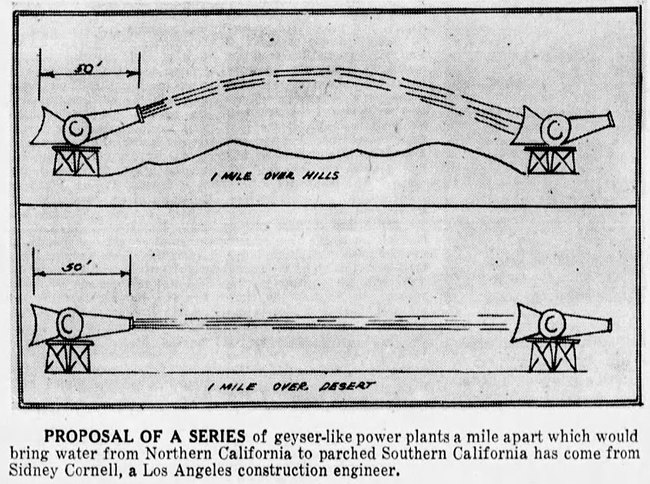
Durham Herald-Sun - Jun 17, 1951
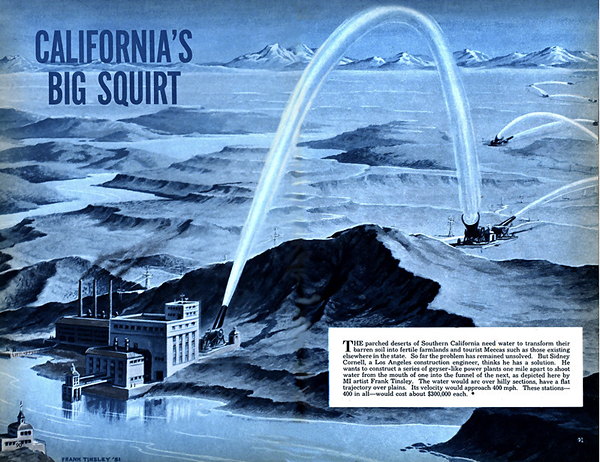
Mechanix Illustrated - Oct 1951 (via California WaterBlog)
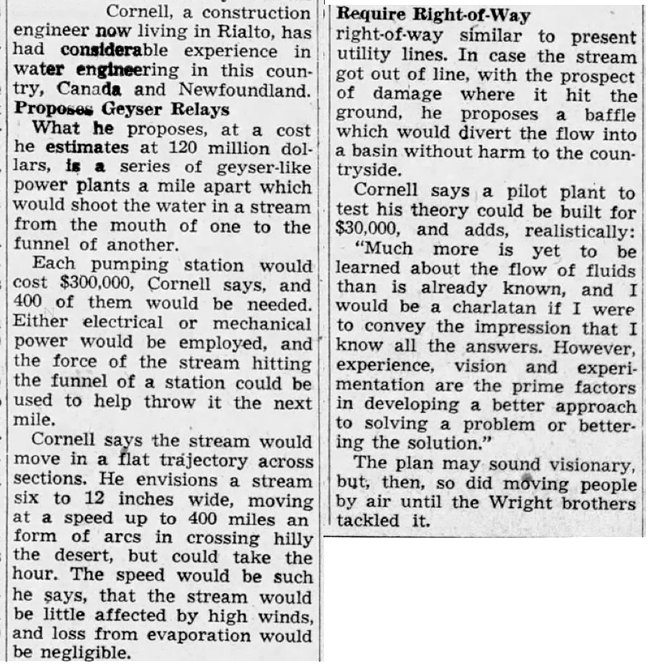
San Pedro News-Pilot - Aug 8, 1951
The idea seems so harebrained that it's hard to understand how Cornell thought it could be even remotely possible. I'm guessing he was persuaded by the phenomenon of laminar flow, by means of which it's possible to get a jet of water to remain tightly focused, with minimal turbulence or scattering. See the video below for an example.
But even so, I'm sure that winds would push the water off-course, despite Cornell's claim that this wouldn't happen. And the cost would be significant.
Posted By: Alex - Tue Jan 24, 2023 -
Comments (8)
Category: Engineering and Construction, Crackpots, 1950s
Coconuts: Production, Processing, Products
Every now and then, WU strives to find a video or book or practice so boring that it merges into true weirdness. I think 311 pages on the humble coconut might qualify. Learn about the ten different cuts of coconut meat, and so much more!



Posted By: Paul - Tue Jan 24, 2023 -
Comments (3)
Category: Boredom, Food, Industry, Factories and Manufacturing, Books
January 23, 2023
Cologne Drunkards
In the late nineteenth century, a brief moral panic emerged about the alleged existence of "cologne drunkards" — society women who inebriated themselves by means of sugar cubes soaked in cologne.Seems like an expensive way to consume alcohol, but I guess it's plausible that some women really did this.

Good Health magazine - Apr 1885

Philadelphia Times - Feb 7, 1893
Posted By: Alex - Mon Jan 23, 2023 -
Comments (1)
Category: Inebriation and Intoxicants, Nineteenth Century, Perfume and Cologne and Other Scents
Mystery Gadget 104
What's so special about this glass brick? What was its origin and use?The answer is here.
Or after the jump.
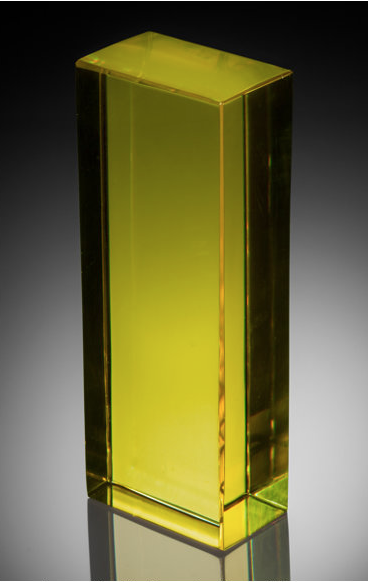
More in extended >>
Posted By: Paul - Mon Jan 23, 2023 -
Comments (1)
Category: Technology
January 22, 2023
Welsh translation
2008: Since all official road signs in Wales are bilingual, transportation officials emailed the English text of a new sign to a translator and promptly received back a response in Welsh, which they placed on the sign. And the sign went up on the road.Welsh speakers later pointed out that the Welsh text read, "I am not in the office at the moment. Send any work to be translated."
According to Google Translate, the correct Welsh text should have been: "Dim mynediad i gerbydau nwyddau trwm. Safle preswyl yn unig."
More info: BBC News

Posted By: Alex - Sun Jan 22, 2023 -
Comments (0)
Category: Mistranslations
Follies of the Madmen #553
In 1970, everything was psychedelic, including kids' vitamins. The subtext of handing out groovy pills could not be denied.
Posted By: Paul - Sun Jan 22, 2023 -
Comments (1)
Category: Advertising, Children, Nutrition, Psychedelic, 1970s
| Get WU Posts by Email | |
|---|---|

| Who We Are |
|---|
| Alex Boese Alex is the creator and curator of the Museum of Hoaxes. He's also the author of various weird, non-fiction books such as Elephants on Acid. Paul Di Filippo Paul has been paid to put weird ideas into fictional form for over thirty years, in his career as a noted science fiction writer. He has recently begun blogging on many curious topics with three fellow writers at The Inferior 4+1. Chuck Shepherd Chuck is the purveyor of News of the Weird, the syndicated column which for decades has set the gold-standard for reporting on oddities and the bizarre. Our banner was drawn by the legendary underground cartoonist Rick Altergott. Contact Us |

